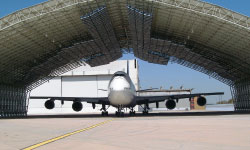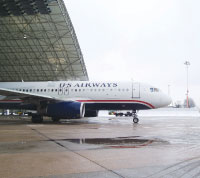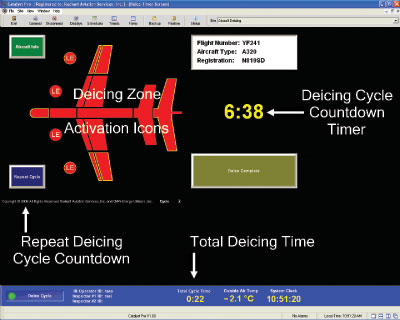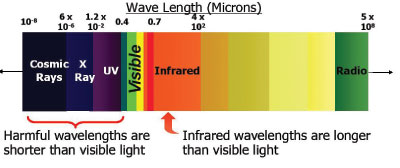
Features
Airports
Infrared Deicing: Giving glycol a run for its money
While the US Environmental Protection Agency reportedly contemplates implementing an effluent limit guideline that will require airlines to conduct glycol mitigation, New York’s John F. Kennedy International Airport (JFK) is enjoying a 90% reduction in glycol use in a new infrared (IR) deicing system.
March 28, 2008 By Carroll McCormick
 |
| JFK’s infrared deicing system can handle aircraft up to the B-747 classics. |
While the US Environmental Protection Agency reportedly contemplates implementing an effluent limit guideline that will require airlines to conduct glycol mitigation, New York’s John F. Kennedy International Airport (JFK) is enjoying a 90% reduction in glycol use in a new infrared (IR) deicing system. Designed and built by Radiant Aviation Services, a US-based wholly-owned subsidiary of the Canadian company Radiant Energy Corporation, the patented InfraTek system relies almost entirely on IR, which lies just to the right of the visible spectrum, to deice aircraft.
The Port Authority of New York and New Jersey commissioned the US$9.5-million system in time for the 2006-2007 winter season. “I like that it is an alternative to glycol. It is reliable, based on our Newark experience,” says Richard Louis, program director for JFK redevelopment and an early champion of the Radiant system.
At the Newark International Airport, Continental Airlines has been operating a Radiant system sized for aircraft up to the B-757 since 2000. To date the airline has used it to deice over 1,500 aircraft. “Airlines can deice in a controlled environment, the process is predictable and it is cost-effective. Continental’s experience has been very good. That is why we discussed the possibility of a common-use system here at JFK with our airline community and jointly decided to try one,” Louis says. The system’s virtues were put to a big test during an ice storm on March 15-16, 2007: Even while the airport at one point reportedly ran out of glycol, the IR system continued to process aircraft. The traditional deicing facilities were taking as long as an hour to an hour and a half and spraying between 3,000 and 5,000 gallons of glycol, at a cost of about $10 per gallon, to deice a single 747, according to anecdotal reports from airline managers during debriefing meetings. The Radiant system, on the other hand, continued to work efficiently. “Our average aircraft “block” time (aircraft brakes on to brakes off) was less than 28 minutes. Even the B-777 and A-340 sized aircraft had an average block time of less than 43 minutes,” says Ian Sharkey, director, deicing services, with Radiant Aviation Services.
 Advertisement
How infrared deicing works Below the ceiling of a Radiant deicing enclosure hang IR panels grouped into heating zones arranged in roughly the shape of the biggest aircraft the system can handle. Depending on the size of the plane being deiced, fewer or more panels are turned up to full power simply by selecting the appropriate, pre-programmed heating zone for each aircraft type on a computer screen; the rest idle at a standby power level. IR does not heat the air. Rather, it penetrates frost, snow or ice on the plane to a depth of about two microns, causing the molecules to vibrate rapidly. The resulting heat starts the melting process. Only after a plane’s surfaces are dry will IR start to heat the skin, but to a lesser degree than the sun’s heat or that of deicing fluid. At that point the appropriate zones are turned down to standby power levels. |
Before joining Radiant, Sharkey worked from 1993 to 2000 establishing and managing the airport operations of Canada’s glycol recovery program for Hudson General Aviation Services on behalf of airlines. He was also responsible for establishing deicing operations at Toronto Pearson’s centralized deicing facility. Louis comments on the quick deicing times, even in poor weather: “This system allows a much more stable price structure and a lower cost associated with predictability. Because we have a departure allocation process in place at JFK during winter operations, the airlines have a great incentive to make their allocated slots; they like predictability.”
Predictability comes in several forms with the Radiant system. Since the deicing takes place under cover, deicing is not a running battle with bad weather, and aircraft stay uncontaminated until they exit and begin taxiing to the runway. In heavy winter storms it is also less likely that planes will exceed their maximum usable holdover time than with existing methods. Airlines like that, since if an aircraft misses its departure slot, it could wait a long time for another to become available.
The Radiant system complies with the Federal Aviation Administration (FAA) Advisory Circular 150/5300-14 for the design of aircraft deicing facilities. Radiant has approvals or “no technical objections” from key aircraft manufacturers such as Bombardier, Boeing, Airbus and Embraer.The system occupies a 260-foot x 260-foot (79-metre x 79-metre) footprint and is 84-feet (25.6 metres) high. It provides the recommended International Civil Aviation Organization wingtip clearances inside, with room for a deicing truck to move around the aircraft to perform inspections and, when necessary, apply anti-icing fluids after the snow and ice has melted; no glycol application is required after frost removal.
Sized to accommodate about 95% of the aircraft types that use JFK, the system can accommodate any plane up to the B-747 classics and some B-777 types. “Airlines wanted the system to be as large as the site could accommodate. We picked the 747-300 as the maximum size because it accommodates the bulk of our passenger aircraft and the majority of cargo aircraft,” says Louis.
The JFK system is the third one to be commissioned at a North American airport for regular deicing operations: The first was an RJ-sized system commissioned at the Rhinelander-Oneida County Airport, Wisconsin in 1998; some of its systems and programming are scheduled to be updated. The second is the Newark system, which Radiant owns and Continental operates. The Port Authority chose Radiant based on an analysis of performance data from Continental’s IR system; Newark has been the proving ground for IR deicing in a busy airport environment. “All of Continental’s Radiant system operational records are computerized. We have very accurate records,” says Sharkey.
The JFK system is located adjacent to Hangar 12, the former TWA aircraft maintenance facility – a 12-minute taxi ride away from the winter departure runway 4L/22R. Already a proven centralized site for traditional deicing operations, it relieves some of the congestion caused by dispersed deicing operations at gates, in alleyways between buildings and on taxiways.
“We have about 1,200 daily operations. There has been a cooperative effort between us and the airlines to improve our ability to keep the runways open longer during winter operations and the airlines wanted more deicing capability. We needed a permanent central site for deicing and that property was available to us,” Louis explains. The FAA partnered with the Port Authority with contributing funds.
| Not in Canada yet, eh? The appearance of the Radiant Energy Corporation’s InfraTek deicing systems at airports in northern climates suffered a severe blow after 9/11, the aftermath of which brought many air traffic management and airport infrastructure projects to a thundering halt. The company has since regained some of its earlier pace, with interest from other airports, the US military and the signing last November of an exclusive distribution agreement with Jet Enviro Deicing LLC (JEDI) to distribute its deicing systems in Alaska. It’s first goal is to establish a JEDI-owned deicing service center at the Ted Stevens Anchorage International Airport. The facility will be capable of deicing aircraft as large as a Boeing 747-8. As for setting up infrared deicing systems in Canada, there appears to be nothing barring their deployment, says Ian Sharkey, director, deicing services with Radiant Aviation Services. “I am not aware of any technical roadblocks or regulatory issues that would prevent our InfraTec systems from being used in Canada.” |
The Port Authority, the airline community and the JFK air traffic control tower worked together to place any departure bottleneck before the system, not after it. “The Port Authority requires that during major storms, every plane must have a departure slot before it is allowed to come out for deicing. The Port Authority and the control tower liason so planes should then be able to go directly to the runway for takeoff,” says Sharkey. Louis adds, “You have a clear shot to the end of the runway after you deice.”
Although the Port Authority, as airport operator, is not in the deicing business, it felt that taking this initiative was necessary to provide needed capacity, as passenger traffic has grown from 31.7 million in 2003 to an estimated 42 million in 2006. The system operates on a cost-recovery basis. “Our goal is to recover all costs to provide the service on a long-term basis. We publish rates and airlines have the option to sign up on an annual basis or as per-use users,” Louis explains. Radiant signed a 20-year contract to operate and maintain the system, which has an operating life of 20-plus years; ventilating fans are the system’s only moving parts.
Radiant is responsible for marketing and providing the deicing services to the airlines. It also established the manner in which all deicing facility operations – communication protocols and airport and airline coordination are accomplished. Subcontractor Contego Systems handles the day-to-day operations. The system itself is operated by one person, with additional staff performing aircraft marshalling, inspections and anti-icing, in accordance with customer airline policies and procedures.
Radiant signed up five airlines, including US Airways, Air Jamaica and a major European flag carrier for the 2006-2007 season and provided deicing services to eight other companies on an ad hoc basis. Two more US carriers and a second major European flag carrier signed with Radiant for the 2007-2008 season, and had already received deicing, along with seven ad hoc customers, by January 2008. As of early 2008 a number of other US and international airlines were in the final stages of technical and/or contract approval to use Radiant’s services.
System capacity is five to seven planes an hour and per-plane deicing time is as good or better than with glycol deicing, says Sharkey. “We are looking for an average complete throughput time of under 15 minutes for a B-747. With truck deicing you have to get the aircraft parked, the pilot has to configure the plane for spraying, drive trucks in, communication … it is only at this point that most deicing companies start the clock. With our system we start deicing as soon as the plane enters the system. We are using dead time and picking up efficiencies. “When an aircraft comes in, we have IR coming from the panels to all points of the aircraft simultaneously. We observe a fairly linear increase in deicing time as the aircraft get bigger. With traditional deicing methods, the increase in deicing time can be exponential as aircraft size increases.”
Pricing predictability is guaranteed. “We have lower, more consistent variable operating costs, so we can offer fixed pricing,” Sharkey explains. “With natural gas we know what an hour at full power will cost. Our customers at JFK know exactly what it will cost. We are charging them fixed prices per plane – one price for frost, another for snow and ice. With glycol, who knows (what the cost will be until the deicing is completed)?” That said, Louis notes that lower deicing cost is not the only point of the exercise. “This facility is one of our best-management practices for minimizing glycol use on the airport as a whole.”
 |
| Top: Mouseclicks control the deicing process in Radiant’s deicing system. (All images courtesy of Radiant)
Bottom: The location of infrared emissions on the electromagnetic spectrum. |
 |